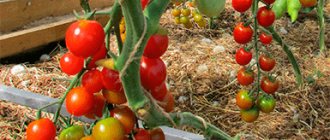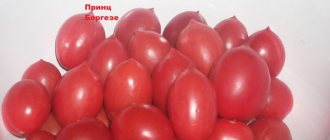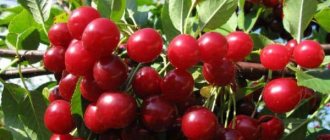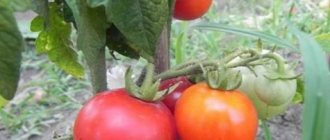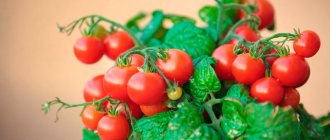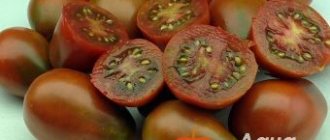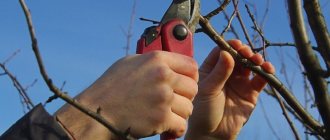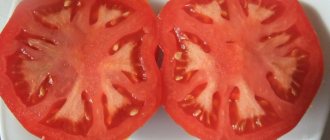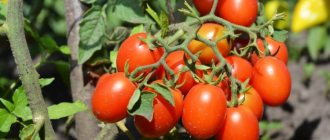Yellow cherry is a popular old variety of cherry tomato. It received registration in the register of agricultural achievements in 1997 and is intended for cultivation on private farms. The originator is the agricultural company Gavrish.
| Height | Landing location | Ripening time | Fruit color | Fruit size | Origin | Fruit shape |
| Tall | Greenhouse, Open ground | Early ripening | Yellow | Small | Variety | Round |
Description and characteristics of the variety
Tomatoes Yellow Cherry from Gavrish are tall indeterminates. Average height is 2 meters or more. The variety is early ripening, from germination to ripening 95-100 days. The plant is powerful, the leaves are dense, slightly corrugated, dark green. The tomato is very leafy, the number of stepsons is small. The variety is intended for cultivation in open areas and in film greenhouses.
The taste of the fruit is highly dependent on the amount of heat, sunlight and nutrition.
The first inflorescences are simple, containing 15-20 tomatoes. The following are complex, branching; 30-40 small round tomatoes simultaneously develop on one brush. A ripe cherry cluster resembles a bunch of grapes, the fruits are small, 15-25 grams each. The skin is bright yellow, dense, and there is a lot of liquid content inside. Ripe tomatoes are sweet and juicy.
Rules for growing the variety
For planting, seedlings that are just over one month old are required. It is recommended to grow tomatoes in an area that is illuminated by the sun. Even if you plan to plant tomatoes in a greenhouse, it is advisable to choose a sunny place. The Yellow Cherry variety needs sufficient lighting for successful development.
Stepsonning is mandatory. To do this, leave the main and main stem, one stepson. After the bush grows, you will need to pinch the top part and stop further growth of the tomato bush.
Tomatoes of the Yellow Cherry variety require comprehensive care for successful cultivation.
- Watering should be regular and moderate. It is advisable to increase the amount of watering only during flowering and fruit ripening. At the same time, you need to monitor the soil moisture. If you overdo it with watering, there is a risk of rotting of the tomato root system.
- Removing weeds and loosening the soil are mandatory measures for successfully growing tomatoes. Working with the soil increases the chances of getting a good harvest.
- The application of fertilizers for the Yellow Cherry variety is considered mandatory. Additional mineral components contribute to the proper development of tomato bushes and a good harvest.
Such an integrated approach is mandatory for tomatoes of the Cherry Yellow variety.
Advantages and disadvantages
Pros:
- Early ripening.
- Sweet and fragrant.
- When seaming, tomatoes do not crack. They look beautiful in assorted jars.
- The bush is capable of bearing fruit until frost.
Minuses:
- Low disease resistance. Late blight, fusarium and cladosporiosis occur frequently. Tobacco mosaic virus – less common.
- Huge bushes take up a lot of space, especially in greenhouses, and the weight of the crop is incomparable with ordinary tomatoes.
- They react to lack of nutrition and sun by reducing their taste.
Fruit characteristics
Tomatoes of this variety are smooth and round. Tomatoes weigh from 15 to 20 grams; at the ripe stage, the fruits are yellow cherries. On average, one bush can yield about one kilogram of fruit.
If you read the reviews, it’s quite rare, but it happens that the harvest from a bush is three kilograms of tomatoes or more. The fruits of the variety are ideal for whole-fruit canning, table decoration and fresh consumption.
The characteristics of tomatoes are made in a positive way, because tomatoes really look beautiful and appetizing, which is fully proven by their description and reviews of many summer residents.
The taste of each tomato depends on where it grows - if the tomatoes grew in the shade, then instead of sweetness a slight sourness may appear. In general, Cherry tomatoes are designed for growing in open ground, but you can also plant tomatoes in a greenhouse.
Yellow cherries have the only and most important drawback - high susceptibility to certain types of pathogens:
- late blight;
- tobacco mosaic;
- fusarium;
- cladosporiosis.
Golden cherry has a number of important advantages:
- high productivity;
- possibility of canning with brushes;
- early ripening fruits;
- excellent taste.
Features of cultivation and storage
Seed producers recommend forming the bushes into one stem, removing all the stepsons. This method will allow you to get ripe tomatoes 1-2 weeks earlier than when growing in 2-3 trunks. When grown with one stem, the plant will form up to 10 clusters per season; the tomatoes will be larger and sweeter than those grown on bushes with 2 stems. Planting pattern 40x60 cm.
The variety does not resist diseases well, so it requires constant monitoring and proper agricultural technology. Tomatoes should not be thickened or allowed to have too much moisture.
Ripe fruits are not suitable for long-term storage. At home, they quickly soften and lose their taste.
Disease Prevention
This variety can be affected by fungal diseases and suffer from pest invasions.
However, reasonable prevention helps to avoid both. According to the rules of crop rotation, tomatoes cannot be planted in close proximity to potatoes, and also cannot be placed in places where nightshades grew last year.
You can’t thicken the plantings, neglect rooting, loosening and weeding. The greenhouse must be regularly ventilated to avoid high humidity.
To prevent late blight and rot, plants are sprayed with Bordeaux mixture, copper sulfate, and calcium nitrate. It is recommended to sprinkle the soil with stove ash or water it with ash infusion.
In addition, you can water with a manganese solution. At the first sign of aphids or other insects, the leaves should be washed with a soapy solution.
You can drive away pests with harmless biological products, but in case of serious damage you need to use insecticides.
Agricultural technology
Seed preparation
The main condition for a good harvest is proper planting of seeds. First of all, prepare the soil from soil, peat and sand. All ingredients are mixed well and poured into prepared wooden or special store-bought boxes.
The seeds are washed in a solution of potassium permanganate and soaked for 12 hours in a growth stimulator. Planting material must be planted in prepared soil, having previously made holes one centimeter deep. The seeds are sown at a distance of two centimeters from each other. Sprinkle the top with earth or peat. After all the work, the boxes are covered with film to create a greenhouse effect and rapid seed germination.
When the first sprouts appear, the containers with seedlings are taken out to a windowsill illuminated by daylight and the film is removed. If there is a lack of light, additional lighting with lamps will be required.
When the first 2-3 leaves appear and the root system is strengthened, the seedlings are transplanted into separate peat pots and other containers. Plants are watered regularly.
Attention! Watering tender sprouts at the first stage of development is best done with a spray bottle, using a fine watering can. A week before planting in open ground, the sprouts are hardened
The seedlings are taken outside for several hours, then for a day, and at the end they are left for the whole day.
A week before planting in open ground, the sprouts are hardened. The seedlings are taken outside for several hours, then for a day, and finally left for the whole day.
Working with seedlings
Seedlings are planted in open ground or a greenhouse at the age of 65-70 days. Before planting plants, you need to choose a place and prepare the soil.
Important! The place for planting the crop should be sunny. The earth is loosened, cleared of last year's leaves, roots, and other weeds.
For soil fertility, mineral fertilizers are used, previously diluted in water, mullein or chicken droppings.
Planting of seedlings is carried out after the threat of frost has passed and warm, sunny days have arrived. In the garden bed, plants are planted at a distance of 50-60 centimeters from each other. There should not be more than 3 crops per square meter. As the seedlings grow, they require the formation of a bush and gartering to strong supports.
Pinching will improve the yield of the bush. To do this, leave the main and main stems, one stepson, and the rest are removed. When the plant reaches the desired height, pinch off the top
It is important to regularly water the crop, remove weeds from the garden bed, and loosen the soil. A week later, the first fertilizing is applied with mineral fertilizers, chicken droppings, and mullein.
Feeding is carried out at least three times during the season.
Attention! A prerequisite for good fruiting of the plant is regular mulching and loosening of the soil (preferably with sawdust), fertilizing, watering
Diseases
When deciding to grow a golden miracle, you need to prepare to protect it from diseases and pests. It is better to prevent the moment of illness in advance than to fight microorganisms when the crop is already affected.
Plant diseases:
Tobacco mosaic virus
Yellow tomatoes often suffer from cladosporiosis, especially if they grow in greenhouse conditions. The disease is recognized by yellow spots and plaque on the leaves. To combat the disease, commercial chemicals are used. Maintaining optimal humidity (60 percent) and air temperature (30 degrees and no more) in greenhouses will help prevent the disease.
Fusarium is a terrible disease that cannot be cured. The leaves become deformed, acquire a yellow or pale green color, and the veins become lighter. Diseased plants are removed from the bed with roots and burned. To prevent disease, seedlings are planted in well-warmed soil.
Tobacco mosaic virus is characterized by the appearance of yellow spots on the leaves, then they turn pale. Leaf deformation occurs, fruits ripen unevenly and their size decreases. The disease will be prevented by disinfecting seedlings and all gardening equipment using a five percent solution of potassium permanganate.
Diseases and pests
Since the Torbay F1 hybrid has high immunity to diseases, vegetable growers only need to take preventive measures. These include:
- Compliance with the watering regime;
- Sufficient lighting;
- Loosening the soil;
- Weed removal;
- Timely feeding.
The only disease that affects the Torbay F1 tomato is blackleg. Since this disease is incurable, damaged plants must be destroyed and the beds treated with special fungicides.
In greenhouses, the hybrid can be attacked by greenhouse whitefly. Confidor will help get rid of the pest. The drug is diluted in water at the rate of 1 ml per 10 liters. This mixture is enough to treat 100 square meters. meters of landings.
When spider mites or aphids appear on the bushes, spray the tomatoes with a soap solution.
The drug “Prestige” will help against the Colorado potato beetle.
Landing
Seeds for seedlings are sown at the end of March (if they plan to grow in greenhouses) or in mid-April (if they plan to plant seedlings in open ground).
An important feature of the variety: the taste of the fruit largely depends on the light, so the place for the garden bed must be chosen accordingly.
Tatyana Orlova (Vasilidchenko) (candidate of agricultural sciences):
Tomatoes grown outdoors in natural sunlight will always be tastier and sweeter than those grown in intense, but artificial light. Vitamins, sugars and aromatic substances in fruits are formed under the influence of ultraviolet radiation.
Sowing
The seeds must be treated with a manganese solution and germinated in a damp cloth. For sowing, take light soil, combine it with peat and mineral fertilizers. For disinfection, the soil is calcined in the oven.
The seeds are deepened into the ground 0.5-1 cm, moistened with warm water from a spray bottle. The box is covered with polyethylene and left at a temperature of 24-25°C until the first shoots.
Seedling
Sprouts appear in about a week. The film is removed from the box and the seedlings are watered for the first time with warm water. For 6-7 days, the temperature is lowered to 16°C, and the box is transferred to the windowsill.
Watering is done every 10 days. At the stage of 2 true leaves, the seedlings are planted in separate containers.
Tatyana Orlova (Vasilidchenko) (candidate of agricultural sciences):
Picking is usually carried out 15-18 days after emergence.
Transfer
Plant productivity depends on the quality of care
Two weeks before transplanting, seedlings begin to be taken outside for hardening.
Prepare the bed in advance: disinfect the soil with manganese, apply fertilizer, and dig it up.
The holes are placed at a distance of 40 cm from each other, pegs for garter are installed. There is a space of 60 cm between the rows.
Compost, ash, and ground eggshells are placed in the holes; The plants are watered abundantly with warm water.
For good growth and productivity, it is recommended to form the bush into 1 stem. It needs to be tied up, preferably to a high support. Water once every 10 days with warm water strictly at the root (or by drip method).
Tatyana Orlova (Vasilidchenko) (candidate of agricultural sciences):
The frequency of watering depends on the temperature and soil condition. Light soils dry out faster, loamy soils dry out more slowly. During the hot period, water every 3-4 days; in cool weather, once every 10 days is sufficient.
After watering, the plants are hilled up and the soil is loosened. Instead of loosening the soil, you can mulch it - this will reduce moisture evaporation and the number of weeds.
For abundant fruiting and a sweet taste of fruits, regular feeding is necessary. Fertilizers are applied every 2 weeks, if possible in liquid form (can be combined with watering).
If there is a clear lack of any minerals, it is recommended to carry out foliar treatments on the leaves - they make up for the nutritional deficiency in the shortest possible time.
